Do you ever just want to get away from it all? Earlier this year, I was anxious to book some kind of Urlaub, any kind of Urlaub, to escape the mundaneness of my daily life in Germany, i.e. getting my kids dressed in the morning, working, going grocery shopping, picking my kids up from daycare, lugging them around in my bike trailer without wearing a helmet, going to the same Spielplatz over and over again, giving them a bath, putting them to bed, and then repeating everything more or less in the same order for months on end. My husband and I thought about where we could go and what we could do with two young kids in early April. We decided to travel to La Gomera, the third smallest Canary Island, and, while we escaped Germany for a week, we couldn’t escape the Germans.
I’ve written before in a previous newsletter about the most popular Urlaub destinations for Germans, and therefore, I am well aware that Spain is second on the list. And, while I thought everyone flocked to Mallorca and Andalusia, unbeknownst to me, the Canaries seem to be the most susceptible to the infamous German vacation infiltration. In fact, the Spanish government reported that the Canary Islands were the top destination for tourists in March of last year. When we arrived at our hotel, the receptionist spoke perfect German, signs in German on the walkways instructed guests to avoid stepping on caterpillars, and, even though I didn’t notice any Jack Wolfskin jackets (ok, I saw one Jack Wolfskin vest and a few Jack Wolfskin fanny packs), my highly trained eye can spot Germans from a mile kilometer away.
Only after having traveled to La Gomera would I be able to point to the Canary Islands on a map, which is why it came as a surprise to me that so many people know about the island. The Canary Islands are an autonomous community belonging to Spain and are located about 100 kilometers off the northwestern coast of Africa. The archipelago was formed by volcanic eruptions millions of years ago and consists of eight main islands: Tenerife, Fuerteventura, Gran Canaria, Lanzarote, La Palma, La Gomera, El Hierro, and La Graciosa. While the landscapes are cool and the beaches are nice, one of the main draws for me was the weather, which, at a sunny, breezy 70 degrees Fahrenheit due to the subtropical climate of the Canaries, is basically year-round swimsuit weather for this Wisconsinite.
Of course, being surrounded by Germans on a Spanish island for a week led me to make the following observations:
When in doubt, speak German
Located in central Europe, Germany shares land borders with nine countries: Denmark, Poland, the Czech Republic, Austria, Switzerland, France, Belgium, Luxembourg, and the Netherlands. Perhaps due to its geographic location and sheer population size as the most populated country in the European Union, German is the second most spoken language in Europe. While it may seem like a no-brainer that German is the official language of Germany and Austria, it is also the official language of Liechtenstein and the co-official language of Switzerland, Belgium and Luxembourg. Although, the German language somehow manages to transcend even its geographical boundaries. How? For example, when we went on vacation to Zeeland in the Netherlands and even on the tiny island of La Gomera with 20,000 total inhabitants, it was noticeable that most people in the tourism industry speak German. The German language may have been known in the past as the language of writers and thinkers (Dichter und Denker), but I would say that German is now the language of travellers.
Let’s take a look. According to the German Federal Foreign Office, 11.9 million German tourists visited Spain in 2024. That means roughly fourteen percent of the entire German population went to Spain last year, making Germans, along with British and French tourists, the largest group of visitors. Since moving here about ten years ago, I’ve visited Spain for work and vacation a total of five times; you could say that on average, I travel to Spain around every two years. On a side note, I have yet to visit another country in Europe where people are so welcoming and accommodating of children (besides the Netherlands, besides Finland…actually, just anywhere that isn’t Germany). On the other hand, the largest number of visitors coming to Germany are actually our direct neighbors to the west, the Netherlands. In 2023, for example, 4.8 million people from the Netherlands travelled to Germany (26.8% of the total Dutch population). And, although most visitors coming to Germany are from the Netherlands, I would venture to say that most Germans, even those in the tourist industry, rarely speak Dutch, and it is much more common for the Dutch to speak German. Based on my observations, Germans are more likely to learn Spanish or French in school and are quite proud of showing off their linguistic skills, as well as all the German hipsters in Berlin who only speak English. Case in point, a woman sitting next to me on the ferry, who grew up in Germany and was a German speaker, said something in Spanish to the man sitting next to her, only to have him answer her in German. The woman seemed surprised by what she hoped would have been a multilingual exchange; however, the majority of the people on the ferry were from Germany, therefore, it was most likely that the person sitting next to her spoke plain old German.
Creatures of Habit / Gewohnheitstiere
When we first arrived in La Gomera, we were about a week ahead of the Easter break schedule for most schools in Germany. The hotel we were staying at was nowhere near full capacity, and, while there were quite a few Germans staying there, it didn’t seem like these were the only guests. Fast forward to our last few days and a massive influx of German tourists later, and there was definitely a shift in the vibes at dinner. Suddenly, there was a line for the buffet starting at 18:30, which is practically still considered lunchtime in Spain. And, if I looked closely, I noticed that the same people sat at the same tables each evening. Are Germans creatures of habit, or Gewohnheitstiere (habit animals)? According to the National Center for Biotechnology Information, habits highlight a fundamental paradox in the human experience: despite our sense of control and purpose in our lives, a significant proportion of our daily behavior is actually driven by our patterns and routines. For example, I take the same route with my bike everyday to pick up my kids from daycare. If I need to run an errand before or after picking them up, and therefore need to take another route, I sometimes find myself riding along my usual route anyways, almost as if I am subconsciously unable to deviate from my accustomed plan. Habits, of course, serve their purpose in saving our brains time and energy by basically taking away our decision-making capacity. For example, why would you put your brain into overdrive on vacation by picking a different table during dinner, when you can simply stay on autopilot and make a beeline for the table you sat at the previous night? Such is the myriad of German efficiency and risk aversion.
What to do in La Gomera with two small children
When I explained to my son that we were going on another adventure, a.k.a. vacation, he immediately started mapping out the logistics. First, we took our car to the airport, then we took an airplane to Tenerife and from there, we took a ferry to La Gomera. It wasn’t long after we boarded our ferry that I began to feel motion sickness coming on and went to the bathroom to throw up. I told my husband and kids that I would sit in the middle of the ship where there was less movement. After going to the bathroom a second time to throw up, I wanted to check on my family in the front of the ship, only to have a ferry employee shoo me away and tell me to stay in the middle where I would be less likely to throw up. After less than an hour, when we finally docked, I went to rejoin the rest of my family, who unlike me, were unfortunately unable to make it to the bathroom and were not only covered in puke, but surrounded by their own puddles of puke on the ferry seats. Not to mention all of this took place on my husband's birthday. Happy Birsday!
After our ferry episode, my kids were really excited to play on the black sand beaches in La Gomera. We visited two different beaches in San Sebastián and Valle Gran Rey. My favorite beach was just the regular city beach in San Sebastián and even my four-year-old son went in the chilly water with me. The water was so clean and clear that I would have liked to join the locals swimming laps with their snorkels along the buoys in the ocean.
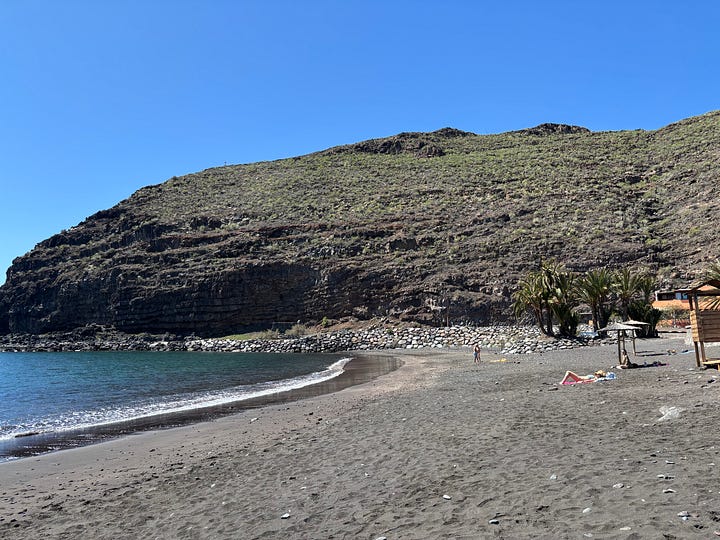
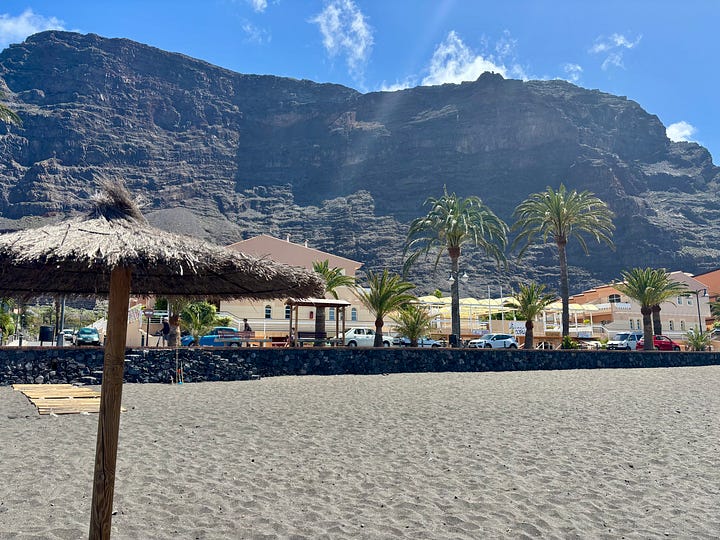
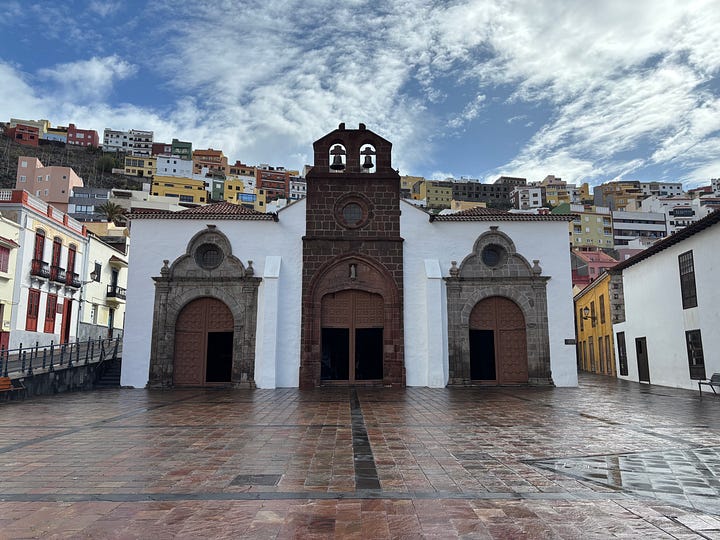
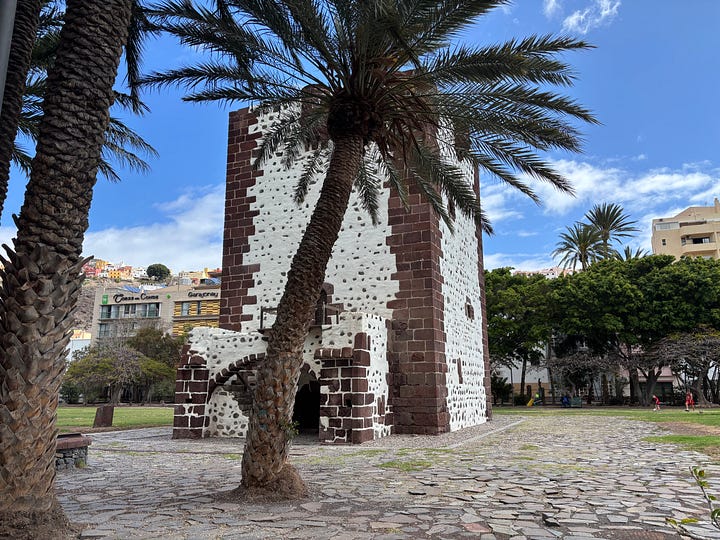
Our hotel was located in San Sebastián and we spent some time strolling around and looking for ice cream and a playground. We found a super cool and colorful playground (why are playgrounds in Germany almost never colorful?) right next to the Torre del Conde, a military fortress built in the 15th century that was used during the Gomeran Rebellion, which marked the island’s definitive conquest by the Spanish. Speaking of conquests, La Gomera also played a significant role as a pit stop for none other than four-time Atlantic voyager and smallpox spreader extraordinaire Christopher Columbus before his journeys to the New World. Señor Columbus prayed for a successful expedition at the Church of the Assumption in La Gomera.
In addition to visiting the historical sites and playgrounds of San Sebastián, we had a rental car and drove to some different spots on the island. Highlights included visiting Valle Gran Rey, which, in my opinion, lives up to the hippy vibes of La Gomera, stopping at a playground surrounded by banana trees in Hermigua, and walking among the ancient laurel forests in Garajonay National Park. Driving around the island, however, is not for the faint of heart. Sometimes I would look out my window over the side of the road and wonder if the simple wooden railing between our car and an incredibly steep mountainous ravine really had any true purpose other than decoration. And, call me basic if you want, but one of my favorite things to do was play with my kids and lounge around the hotel pool with a view of Tenerife and Mount Teide in the distance.
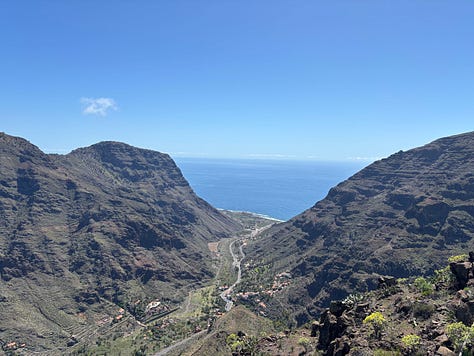


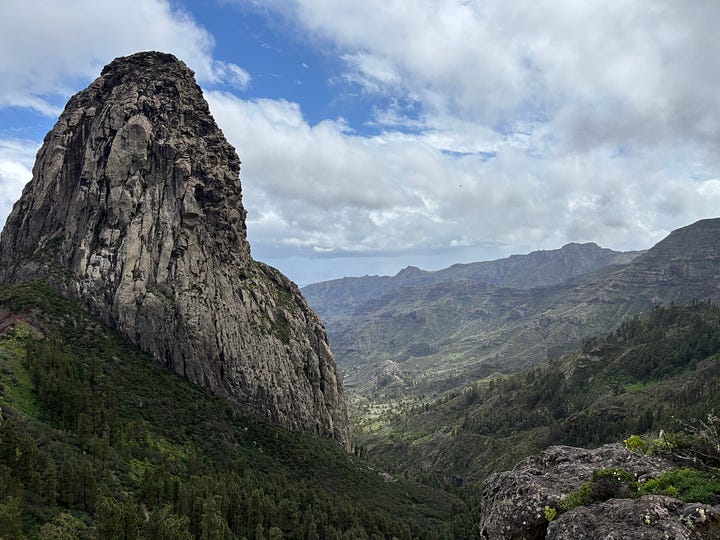
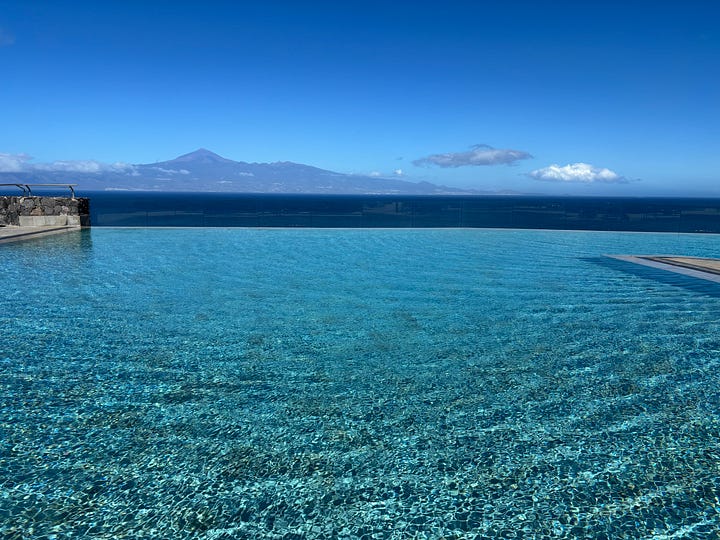
Perhaps the most amazing part of our vacation was the appreciable lack of runny noses and coughing from my kids. If you can imagine, I didn’t even need to pack any tissues with me during outings on La Gomera. As if we were all too well on La Gomera, now that we have been back in Germany for a week, the four of us have sore throats and runny noses and my kids are coughing again. Oh well, I certainly enjoyed it while it lasted. Happy Easter!

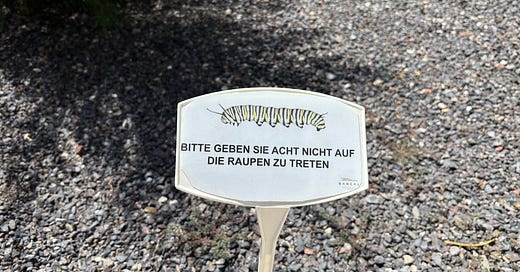



Such a fun read—relatable, funny, and so true about Germans being everywhere (and sticking to routines, even on vacation!). Loved the ferry story—classic parenting moment!